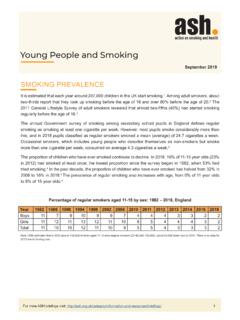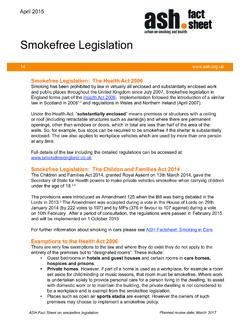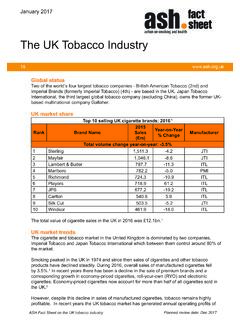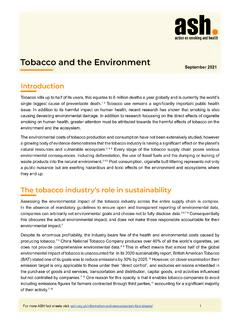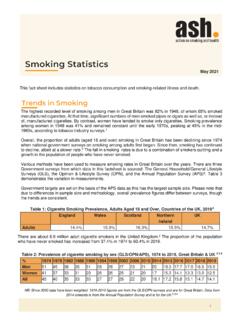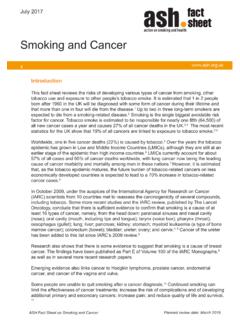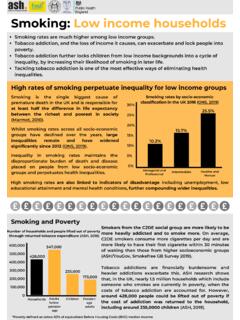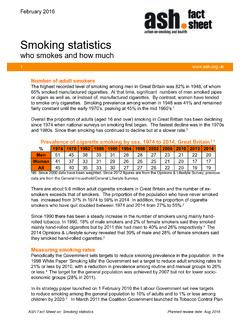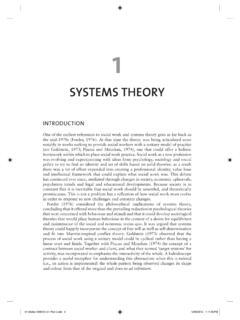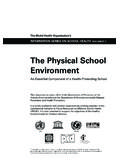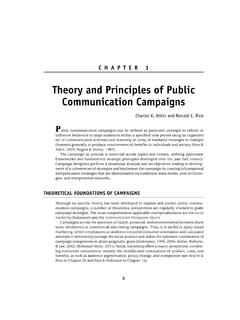Transcription of Health Inequalities and Smoking - Action on Smoking and …
1 For more ASH briefings visit: 1 Health Inequalities and SmokingKEY POINTS Health Inequalities are preventable differences in Health outcomes between different population groups. Reducing Health Inequalities remains a key goal of public policy in England. Because Smoking is so harmful, differences in Smoking prevalence across the population translate into major differences in death rates and illness. Smoking is the single largest driver of Health Inequalities in England. Smoking is far more common among people with lower incomes. The more disadvantaged someone is, the more likely they are to smoke and to suffer from Smoking -related disease and premature death. Improving social conditions is not, however, a sufficient strategy to reduce Smoking prevalence in more disadvantaged groups. The specific drivers of Smoking uptake and tobacco addiction must also be addressed.
2 Smoking is transmitted across the generations in a cycle underpinned by social norms, familiarisation and addiction. Young people with parents who smoke are more exposed to Smoking behaviour, more likely to try Smoking and, once hooked, they find it harder to quit. Smoking is so corrosive to individual, family and community Health that any success in reducing Smoking in disadvantaged groups has knock on benefits for the wider determinants of Health , including through a reduction in poverty. Smoking related Health Inequalities are not restricted to socio-economic status. The poorer Health of people in the north of England compared to the south is in part due to higher rates of Smoking in the north. Smoking rates are also higher among people with a mental Health condition, people in contact with the criminal justice system, looked-after children, and LGBT people.
3 Health Inequalities will be reduced through measures that have a greater effect on smokers in higher prevalence groups. In practice, this means both prioritising population-level interventions which disadvantaged smokers are more sensitive to and targeting interventions on these smokers. WHAT ARE Health Inequalities ? Health Inequalities are preventable differences in Health outcomes between different population groups. For example, people who live on low incomes tend to experience more disease and die earlier than people who live on high Likewise, people in the north of England tend to die earlier than people in the south of These are population differences: they don t apply to every individual but they can be seen across the population as a 2019 For more ASH briefings visit: 2 These differences are most often described across the socio-economic spectrum, for example between people with professional and managerial occupations (and incomes to match) and people with routine and manual occupations such as labourers and bar staff.
4 Figure 1 shows the differences in premature death rates across this spectrum. More than three times as many people in the lowest socio-economic group die early compared to the highest socio-economic group. Figure 1 also reveals a big difference in the premature death rates for men and women: far more men of working age die than women of working age. Figure 1. Age-standardised avoidable mortality rates per 100,000 adults by socio-economic group and gender in England, 2017 (ONS)3 These differences are called Inequalities because we recognise that they are unfair. In a fair society, we would expect everyone to have the same life expectancy, regardless of who they are and where they live. Yet a baby boy born in the London borough of Kensington and Chelsea has a life expectancy of years compared to years in Blackpool. Likewise, a baby girl born in Rutland has a life expectancy of years compared to years in In his landmark 2010 report, Fair Society, Healthy Lives, Michael Marmot and his team began by making clear the moral dimension of tackling Inequalities in Health : Inequalities are a matter of life and death, of Health and sickness, of well-being and misery.
5 The fact that in England today people from different socioeconomic groups experience avoidable differences in Health , well-being and length of life is, quite simply, unfair and unacceptable. Reducing Health Inequalities is a key goal of public policy in England. Box 1 identifies the policy and legislation that promotes this goal at both national and local levels. deaths per 100,000 Deprivation decileWomenMenFor more ASH briefings visit: 3 WHAT CONTRIBUTION DOES Smoking MAKE TO Health Inequalities ? Smoking remains the single biggest preventable cause of death and illness in England. In 2017, 77,800 people died from Smoking -related causes in That s over 200 people every day. Likewise, the impact of Smoking on ill Health is huge: in 2017/18 an estimated 489,300 hospital admissions in England were attributable to Smoking prevalence is associated with almost every indicator of deprivation or marginalisation.
6 Compared to the population as a whole, Smoking is more common among: People with a mental Health condition People with lower incomes People who are unemployed People who are experiencing homelessness People in contact with the criminal justice system People who live in social housing People without qualifications Lone parents LGBT peopleCumulative disadvantage increases the likelihood of Smoking . One study, using a large database of primary care patient data in the UK aged 16+, found that the highest Smoking rates were recorded among groups and localities characterised by single-parent households, living in socially rented accommodation, few, if any, educational qualifications, no access to a car and who reported feeling the area they lived in offered little community The highest rates of Smoking are consistently found among those who are most disadvantaged.
7 For example, in 2014, 77% of people experiencing homelessness Figure 2 shows the difference in Smoking rates in England between the socio-economic groups. Figure 2. Smoking prevalence by socio-economic group, 2019 (Public Health England)8 and professionalIntermediateRoutine and ManualNever worked and long term unemploymentEngland averageFor more ASH briefings visit: 4 BOX 1: LEGISLATION AND POLICY UNDERPINNING WORK ON Health INEQUALITIESH ealth and Social Care Act 2012 The Act enshrines explicit duties on the Secretary of State, NHS Commissioning Board and clinical commissioning groups (CCGs) to have regard to the need to reduce Inequalities in the benefits which can be obtained from Health services. The duty on the Secretary of State extends to functions in relation to both the NHS and public Health .
8 The Act defines CCG responsibilities to help reduce Health Inequalities through integrating local services, the quality reward and public involvement in planning and commissioning. The Act enables providers including the independent and third sector to develop innovative services to tackle complex problems such as Health , Five year forward view 2015 The future Health of millions of children, the sustainability of the NHS, and the economic prosperity of Britain all now depend on a radical upgrade in prevention and public Health . Mental Health Task Force, The five year forward view for mental Health , 2016 People with a long-standing mental Health problem are twice as likely to smoke, with the highest rates among people with psychosis or bipolar disorder. Current incentive schemes for GPs to encourage monitoring of physical Health should continue and extra efforts should be made to reduce Smoking - one of the most significant causes of poorer physical Health for this group.
9 Mental Health inpatient services should be smoke-free by 2018. Department for Health , Towards a Smokefree generation : A tobacco control plan for England, 2017 Central components of the tobacco control plan were commitments to eliminating Inequalities and reducing Smoking prevalence in groups with the highest rates and those where harm is greatest Reducing rates of Smoking during pregnancy, among people with mental Health conditions and among those in low socio-economic groups are key focuses of the planNHS, The NHS Long Term Plan, 2019 Chapter 2 of the 7-chapter NHS Long Term Plan is titled More NHS Action on prevention and Health Inequalities - a key element of the Plan s strategy to meet this objective is through greater focus on the prevention of avoidable illness. Smoking cessation is a prominent feature of NHS prevention plans, with commitments to treating tobacco dependency in the NHS outlined in the Plan.
10 Specific commitments were made for pregnant smokers and smokers with mental Health Health England, PHE Strategy 2020-25, 2019 Public Health England s latest strategy includes a smoke-free society as one of its ten areas identified as being able to deliver the biggest impact for the public s Health over the next five years There is also a significant focus on persistent and growing Inequalities with many of the commitments made around Smoking focussed on targeted interventions to support quit attempts and Smoking prevalence reduction among areas and groups with the highest need For more ASH briefings visit: 5As Smoking is so harmful, any differences in Smoking prevalence across the population inevitably translate into different rates of illness and mortality, Health studies have sought to quantify the specific contribution that Smoking makes to Health Inequalities .

